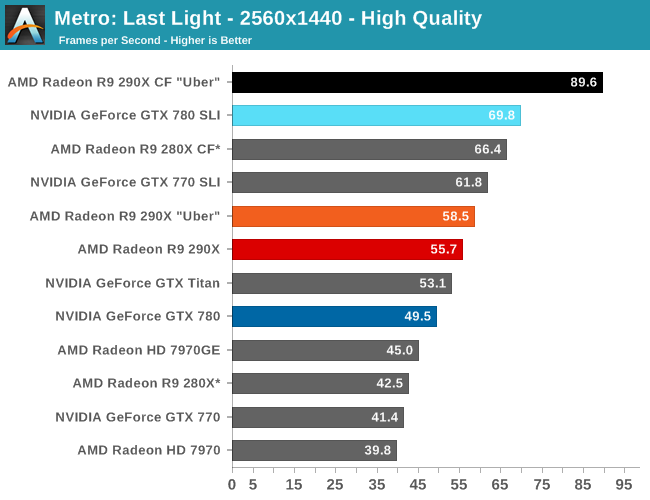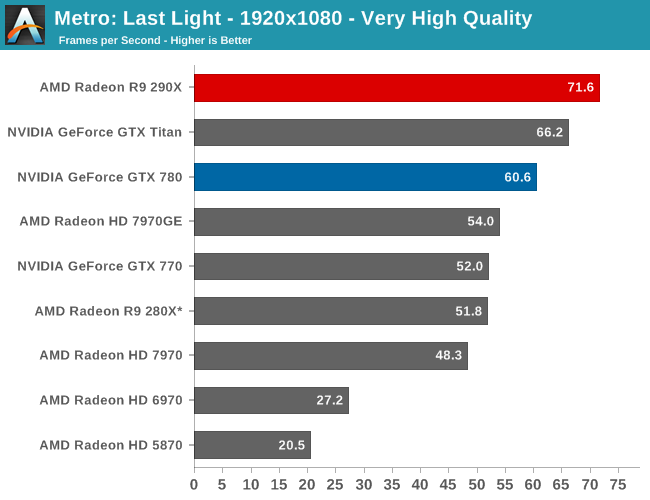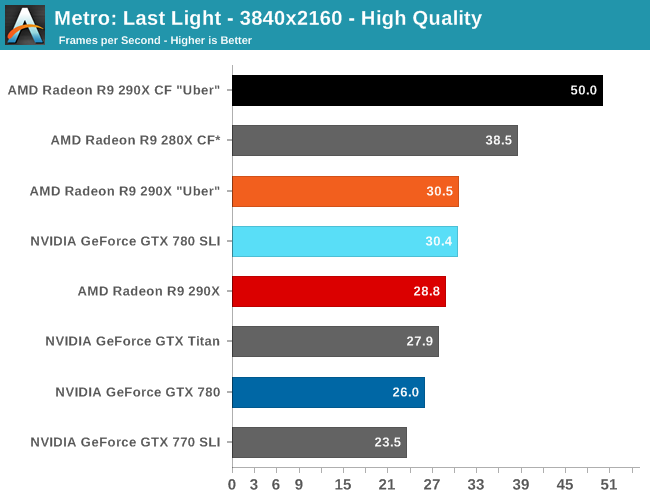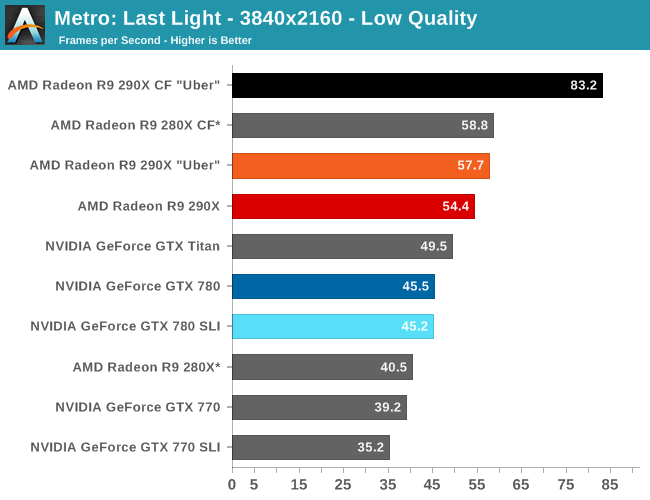The AMD Radeon R9 290X Review
by Ryan Smith on October 24, 2013 12:01 AM EST- Posted in
- GPUs
- AMD
- Radeon
- Hawaii
- Radeon 200
Metro: Last Light
As always, kicking off our look at performance is 4A Games’ latest entry in their Metro series of subterranean shooters, Metro: Last Light. The original Metro: 2033 was a graphically punishing game for its time and Metro: Last Light is in its own right too. On the other hand it scales well with resolution and quality settings, so it’s still playable on lower end hardware.


For the bulk of our analysis we’re going to be focusing on our 2560x1440 results, as monitors at this resolution will be what we expect the 290X to be primarily used with. A single 290X may have the horsepower to drive 4K in at least some situations, but given the current costs of 4K monitors that’s going to be a much different usage scenario.
With that said, for focusing on 4K on most games we’ve thrown in results both at a high quality setting, and a lower quality setting that makes it practical to run at 4K off of a single card. Given current monitor prices it won’t make a ton of sense to try to go with reduced quality settings just to save $550 – and consequently we may not keep the lower quality benchmarks around for future articles – but for the purposes of looking at a new GPU it’s useful to be able to look at single-GPU performance at framerates that are actually playable.
With that said, starting off with Metro at 2560 the 290X hits the ground running on our first benchmark. At 55fps it’s just a bit shy of hitting that 60fps average we love to cling to, but among all of our single-GPU cards it is the fastest, beating even the traditional powerhouse that is GTX Titan. Consequently the performance difference between 290X and GTX 780 (290X’s real competition) is even greater, with the 290X outpacing the GTX 780 by 13%, all the while being $100 cheaper. As we’ll see these results are a bit better than the overall average, but all told we’re not too far off. For as fast as GTX 780 is, 290X is going to be appreciably (if not significantly) faster.
290X also does well for itself compared to the Tahiti based 280X. At 2560 the 290X’s performance advantage stands at 31%, which as we alluded to earlier is greater than the increase in die size, offering solid proof that AMD has improved their performance per mm2 of silicon despite the fact that they’re still on the same 28nm manufacturing process. That 31% does come at a price increase of 83% however, which although normal for this price segment serves as a reminder that the performance increases offered by the fastest video cards with the biggest GPUs do not come cheaply.
Meanwhile for one final AMD comparison, let’s quickly look at the 290X in uber mode. As the 290X is unable to sustain the power/heat workload of a 1000MHz Hawaii GPU for an extended period of time, at its stock (quiet settings) it has to pull back on performance in order to meet reasonable operational parameters. Uber mode on the other hand represents what 290X and the Hawaii can do when fully unleashed; the noise costs won’t be pretty (as we’ll see), but in the process it builds on 290X’s existing leads and increases them by another 5%. And that’s really going to be one of the central narratives for 290X once semi-custom and fully-custom cards come online: Despite being a fully enabled part, 290X does not give us everything Hawaii is truly capable of.


Moving on, let’s talk about multi-GPU setups and 4K. Metro is a solid reminder that not every game scales similarly across different GPUs, and for that matter that not every game is going to significantly benefit from multi-GPU setups. Metro for its part isn’t particularly hospitable to multi-GPU cards, with the best setup scaling by only 53% at 2560. This is better than some games that won’t scale at all, but it won’t be as good as those games that see a near-100% performance improvement. Which consequently is also why we dropped Metro as a power benchmark, as this level of scaling is a poor showcase for the power/temp/noise characteristics of a pair of video cards under full load.
The real story here of course is that it’s another strong showing for AMD at both 2560 and 4K. At 2560 the 290X CF sees better performance scaling than the GTX 780 SLI – 53% versus 41% – further extending the 290X’s lead. Bumping the resolution up to 4K makes things even more lopsided in AMD’s favor, as at this point the NVIDIA cards essentially fail to scale (picking up just 17%) while the 290X sees an even greater scaling factor of 63%. As such for those few who can afford to seriously chase 4K gaming, the 290X is the only viable option in this scenario. And at 50fps average for 4K at high quality, 4K gaming at reasonable (though not maximum) quality settings is in fact attainable when it comes to Metro.
Meanwhile for single-GPU configurations at 4K, 4K is viable, but only at Metro’s lowest quality levels. This will be the first of many games where such a thing is possible, and the first of many games where going up to 4K in this manner further improves on AMD’s lead at 4K. Again, we’re not of the opinion that 4K at these low quality settings is a good way to play games, but it does provide some insight and validationg into AMD’s claims that their hardware is better suited for 4K gaming.










396 Comments
View All Comments
TheJian - Friday, October 25, 2013 - link
Wrong, Zotac price in cart $624. :) Personally I'd buy an OC card for $650 but that's just me.http://www.newegg.com/Product/Product.aspx?Item=N8...
46andtool - Thursday, October 24, 2013 - link
your comment makes no sense, all I see are excuses and misinformation in your post." It doesn't cost less than a GTX780, it only has a lower MSRP." is just stupid, battlefield 4 edition 290xs are already on newegg for $579, the only cheap 780gtxs you will find will be used ones.chrnochime - Thursday, October 24, 2013 - link
What 549? Every 780 on NE goes for 649. I want some of the kool-aid you're drinking.HisDivineOrder - Friday, October 25, 2013 - link
It IS loud. HardOCP have a tendency to be so "hard" they ignore the volume of the card. They aren't the most reliant of sites about the acoustics of a card. Not in the past and not today.JDG1980 - Thursday, October 24, 2013 - link
Regarding 1080p performance, so what? You don't need a $500+ video card to get acceptable frame rates at that resolution. A $200-$300 card will do just fine. $500+ video cards are for multi-monitor setups or high resolution (1440p+) displays.Regarding the noise, that's a problem - AMD clearly stretched things as far as they could go with GCN to reach the current performance level. I know that EK has already announced a 290X waterblock for those enthusiasts who use custom loops. I wouldn't be surprised to see someone come out with a self-contained closed-loop watercooler for the 290X, similar to those that have been available for CPUs for a couple years now. That might help fix the noise issues, especially if it used a dual 120mm/140mm radiator.
46andtool - Thursday, October 24, 2013 - link
we are just now breaking 60fps on 1080p on demanding games at max details, and even more demanding games are just around the corner so your telling people what exactly? And everybody knows AMD makes retarded reference coolers. So another moot point. Lets-try-and -discredit- AMDs- stellar -new product -anyway -we -can- but- the- only- way- we -know -how -is -by -grasping- at- straws.inighthawki - Thursday, October 24, 2013 - link
BS, there's absolutely nothing wrong with a high end card on a 1080p display. Just look at the benchmarks, Crysis 3 1080p on high, a 7970GE barely hits 60fps, and no doubt that will drop below 60 on many occasions (it's just an average). On top of that, not all games are nearly as well optimized as Crytek games, or are just far more complex. Total War: Rome 2, even the 290X doesn't barely hits 60fps on extreme with MEDIUM shadows. Or maybe look at Company of Heroes 2, and how even the 290X hits a min fps of 37fps on extreme.On top of all of that, high resolution IPS panels are super expensive, not everyone cares enough about that to spend the money. The difference between a quality 1080p and a quality 1440p panel can be almost as much as the video card itself.
patrioteagle07 - Thursday, October 24, 2013 - link
Not really... You can find refurbed ZR30s for under $600If you are going to spend 1k on gfx its rather short sighted to keep your TN panels...
inighthawki - Thursday, October 24, 2013 - link
That's at LEAST several hundred dollars more than the majority of people are willing to spend on a monitor. 1080p TN panels are fine for most people, including most gamers. What people care about is not monitor count, pixel count, or color accuracy. They want high quality shaded pixels and good framerate. This is where high end video cards on smaller monitors comes into play. There are plenty of reasons to do it. Do not confuse your own values as the same as what everyone else wants.ShieTar - Friday, October 25, 2013 - link
Also, an increasing number of players is considering 120 FPS to be the acceptable framerate, not 60FPS.